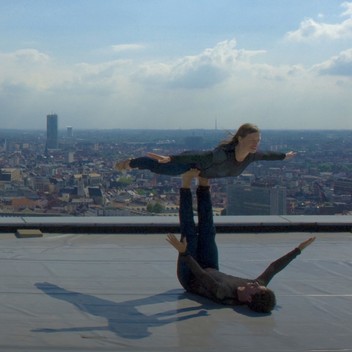Film in concert
La playlist de l'été

Simon Steen-Andersen's decidedly multidisciplinary approach to musical creation has led him to create works in all formats: performance, theater, choreography and even film. As new media develop, his music gradually embraces the integration of samplers, videos, everyday objects and handcrafted constructions, ignoring the categorization of genres and practices.
Simon Steen-Andersen -whose major work TRIO opens ManiFeste at the Théâtre du Châtelet- has established a distinguished reputation in the contemporary music world. While many contemporary composers work with introspective soundtracks, fascinated by augmented material but fairly passive in terms of form, the Danish composer creates music based on a series of events and musical discourse. He prefers low-tech craftsmanship to the high-tech discipline of electronics. When musical creation presents itself as a tragic mirror of the world's collapse, his work is imbued with irony, bite, and vitality.
Playing on the clash between meaning and sound, mastering the hybridization of sources, styles, memories, and expressions, Simon Steen-Andersen brings what has been learned from linguistics into music, just like Luciano Berio did so brilliantly in his day. Faced with the immense diversity of languages in contemporary music, the shared social reality of a system of communication -a language- must exist.
With TRIO, Stockhausen's Hymnen comes to mind: the manipulation of fragments of collective memory - in this case, national anthems - makes it possible to feel the changes made, at the very moment they occur... TRIO, which brings together the Orchestre de Paris, the vocal ensemble Les Métaboles and the Conservatoire's jazz students on May 31, 2024, combines numerous recordings of classical music and jazz: a Bruckner chord, a Miles Davis section, a few bars from Ravel's Daphnis et Chloé, a repeated passage from Handel's Messiah.
Simon Steen-Andersen also draws inspiration from his passion for cinema, from the early experiments of the pioneers of the seventh art (the mastery of editing and sound effects) to recent arthouse films. The archive is not just content preserved in libraries, it's also a history of recording and reproduction mechanisms. The eye listens, music acts.
It would certainly be possible to design an ultra-virtuoso montage, a mashup approaching the one in TRIO with the help of artificial intelligence. But here, the ingenuity of artisanal craftsmanship dominates the screen, along with the lives of those who play here and now, as well as our own cultural collective memory. On the screen, you see Carlos Kleiber rehearsing with his baton for the Dresden Staatskapelle Orchestra. On stage, TRIO's orchestra, jazz band and chorus respond with a flurry of similar strokes. The tour de force is based on these perfectly plotted synchronization and stall effects: a tight, high-speed dialogue between screen and stage, a delightful, sometimes hilarious whirlwind.
"Archives are not just content preserved in libraries, they are also a history of recording and reproduction mechanisms. The eye listens, music acts."
All this presupposes meticulous writing of every moment: Simon Steen-Andersen remains fundamentally an artist of writing. Rather than perpetuating the aberrant division between the concert as "in-the-moment" and the contemporary performance, or even the performative statement that represents the pinnacle of the "now", his works consist of fully written protocols. His art is more montage than process. Everything is premeditated, nothing left to chance. Everything is playful, meticulous, and cheerful: the composer is a gambler in a hurry not so much to win as to raise the stakes.
The challenge that lies ahead for the composer is renewing the prowess and unpredictability of a historical stylization, with highly recognizable elements. There is no magic revealed here, as Steen-Andersen is careful to show us a mechanism at work that will soon go haywire, bringing him closer to one of the founding figures of musical theater: Georges Aperghis. His aim is not so much to impose a concept as to make us feel its multiple effects and variations. Introducing temporary rules, he invites us to go off track, freed from the clutter of sententious profundity.
By Frank Madlener